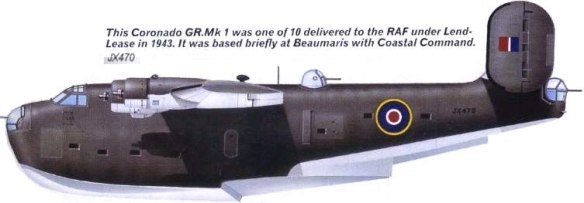Coronados served in combat in the Pacific, in both bombing and anti-submarine roles, but transport and hospital aircraft were the most common. The British Royal Air Force Coastal Command had hoped to use the Coronado as a maritime patrol bomber, as it already used the PBY Catalina. However, the range of the Coronado (1,070 miles) compared poorly with the Catalina (2,520 mi), and the Short Sunderland (1,780 mi). Consequently, the Coronados supplied to the RAF under Lend-Lease were outfitted purely as transports, serving with RAF Transport Command. The 10 aircraft were used for trans-Atlantic flights, staging through the RAF base at Darrell’s Island, Bermuda, and Puerto Rico, though the aircraft were used to deliver vital cargo and equipment in a transportation network that stretched down both sides of the Atlantic, from Newfoundland, to Brazil, and to Nigeria, and other parts of Africa. After the war ended 5 of the RAF aircraft were scrapped, one was already lost in collision with a Martin Mariner and the last four were scuttled off the coast of Bermuda in 1946.
Coronados served as a major component in the Naval Air Transport Service (NATS) during World War II in the Pacific theater. Most had originally been acquired as combat patrol aircraft, but the limitations noted above quickly relegated them to transport service in the American naval air fleet also. By the end of World War II the Coronado was outmoded as both a bomber and a transport, and virtually all of them were quickly scrapped, being melted down to aluminum ingots and sold as metal scrap.
Variants
XPB2Y-1
Prototype with four 1050hp XR-1830-72 engines, one built.
PB2Y-2
Evalutation variant with four 1020hp R-1830-78 engines, modified hull and six 0.5in guns, six built.
XPB2Y-3
One PB2Y-2 converted as prototype for PB2Y-3.
PB2Y-3
Production variant with four 1200hp R-1830-88 engines and eight 0.5in guns, 210 built.
PB2Y-3B
Lend-lease designation for Royal Air Force aircraft.
PB2Y-3R
PB2Y-3s converted as freighters with faired-over turrets, side loading hatch, and seating for 44 passengers, 31 built.
XPB2Y-4
One PB2Y-2 re-engined with four R-2600 engines.
XPB2Y-5
The XP2BY-3 converted as PB2Y-5 prototype.
PB2Y-5
PB2Y-3s converted with four 1200hp R-1830-92 engines, increased fuel capacity and provision for RATO (rocket assisted take-off) gear.
PB2Y-5R
PB2Y-5s converted as unarmed transports some fitted for medical evacuation role.
Variants –
XPBM-1 (Model 162)
Prototype. Powered by two 1,600 hp (1,194 kW) R-2600-6 engines.
PBM-1 (Model 162)
Initial production version. 5× .50 inch (12.7 mm) machine guns. Two R-2600-6 engines. 21 built.
XPBM-2 (Model 162)
Conversion of one PBM-1 as experimental catapult launched long range strategic bomber.
PBM-3 (Model 162B)
Improved version. 1,700 hp (1,270 kW) R-2600-12 engines. 32 built.
PBM-3R (Model 162B)
Unarmed transport version of PBM-3. 18 new build plus 31 converted from PBM-3.
PBM-3C (Model 162C)
Improved patrol version with twin .50 in machine guns in nose and dorsal turrets, and single guns in tail turret and waist positions. AN/APS-15 radar in radome behind cockpit. 274 built.
PBM-3B (Model 162C)
Designation for ex-RAF Mariner GR.1A after return to US Navy.
PBM-3S (Model 162C)
Dedicated anti-submarine aircraft with reduced armament (2× fixed 0.50 in machine guns in nose, single machine gun in port waist position and single gun in tail turret) and increased range. 94 built as new plus 62 conversions.
PBM-3D (Model 162D)
Patrol bomber with increased power (two 1,900 hp (1,417 kW) R-2600-22s) and increased armament (twin 0.50 machine guns in nose, dorsa and tail turrets, plus two waist guns. 259 built.
PBM-4 (Model 162E)
Proposed version with two 2,700 hp (2,015 kW) Wright R-3350 engines. Unbuilt.
PBM-5 (Model 162F)
Version with 2,100 hp (1,566 kW) Pratt & Whitney R-2800 engines.[19] 628 built.
PBM-5E
Variant of PBM-5 with improved radar.
PBM-5S
Lightened anti-submarine variant of PBM-5.
PBM-5S2
Improved anti-submarine aircraft with revised radar installation.
PBM-5A (Model 162G)
Amphibian version of PBM-5, with retractable nosewheel undercarriage. 36 built plus 4 conversions.
Mariner I
British designation for 32 PBM-3B supplied to the Royal Air Force.
